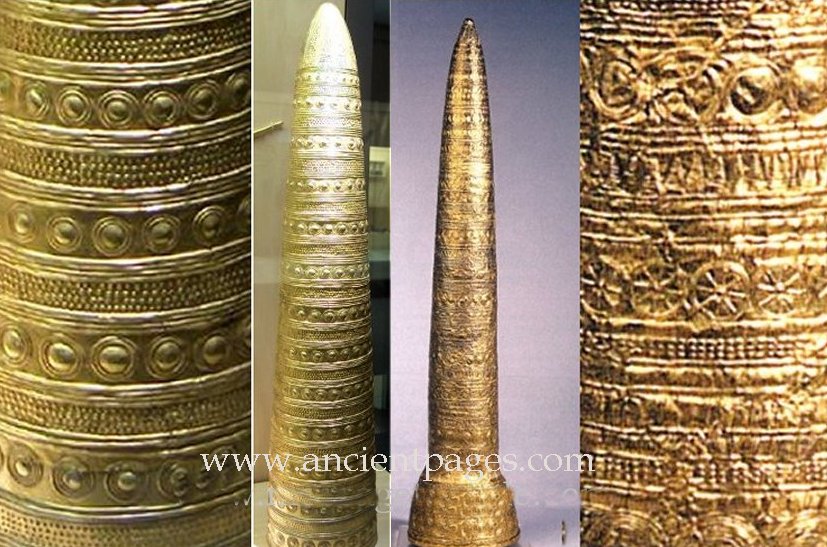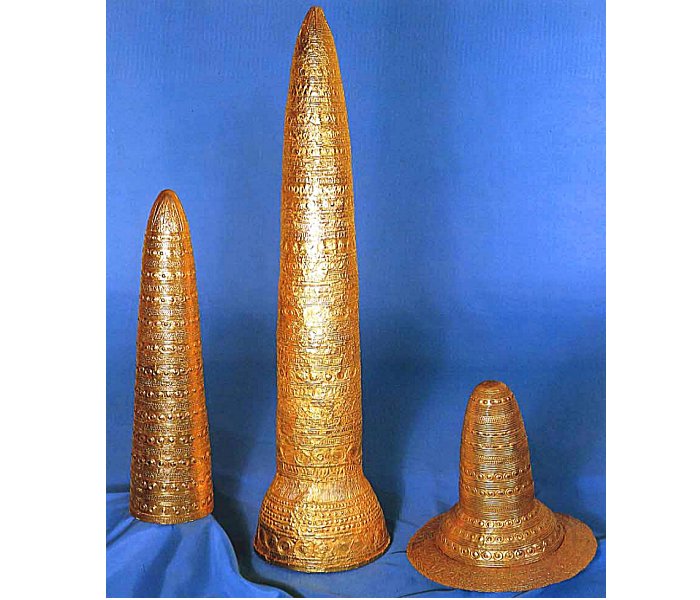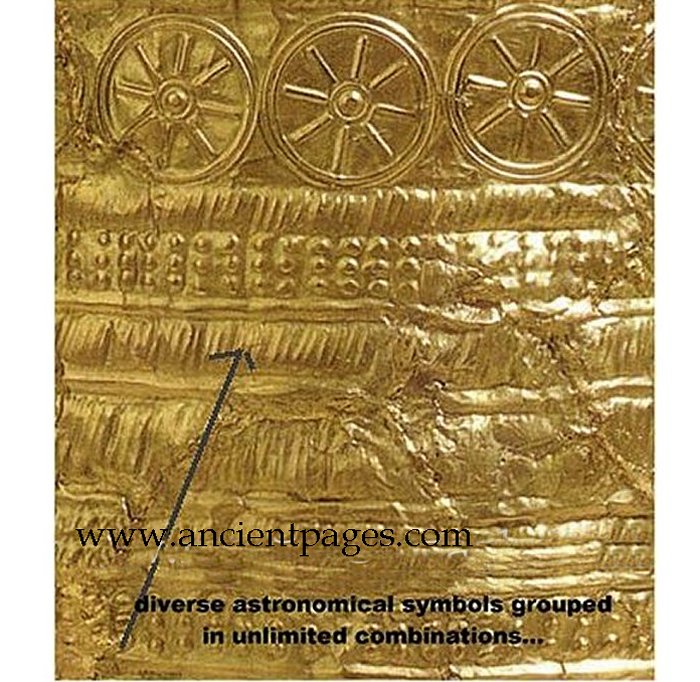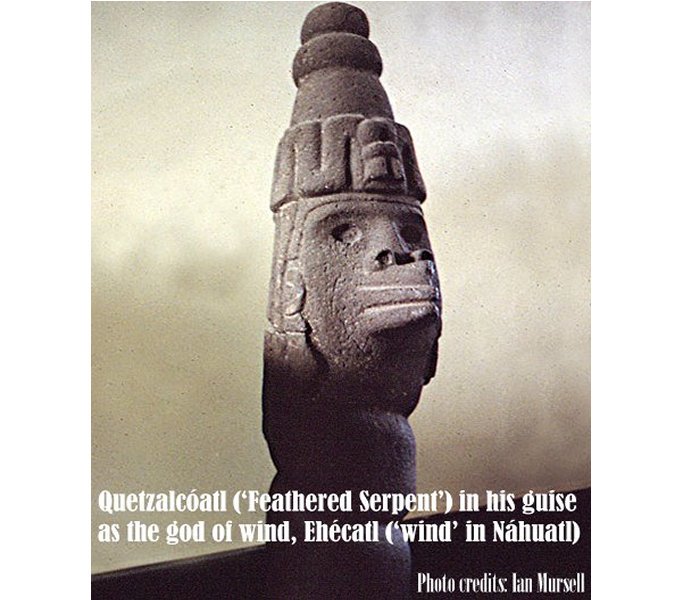Mystery Of 3,000-Year-Old Conical Hats – Was It A Highly Advanced Device?
A. Sutherland - AncientPages.com - They are considered to be "hats of ancient wizards" but their original purpose has baffled scientists for many decades.
Did wizards wear conical hats? Similar hats were worn by many gods. Quetzalcoatl wore his conical cap as Ehecatl, the snake-bird deity, and god of wind feared by the Aztecs, the Sumerian gods were often depicted in similar cone-shaped hats.
Are the circular symbols on the golden hats a proof of a highly advanced astronomical knowledge of the Bronze Age or perhaps the hats were used as cult objects in ceremonies and rituals?
If so, who was the subject of this worship?
Could the Bronze Age people possess such sophisticated astronomical skills as those presented on conical hats? Where did their advanced knowledge come from?
At first, there was only "a piece of sheet metal 8 cm below the surface of the earth. Since this disturbed the work, it was chopped up and thrown away carelessly. It was only when the sheet metal pieces were washed away by the rain that they were recognized as gold and collected by a worker's wife. Georg Raschke, then head of the prehistoric and early history collection of the Germanisches Nationalmuseum, was able to correctly classify the fragments based on the circular ornaments on them. He managed to buy the gold sheets (280 g) and when the site was examined, he found further fragments (30 g) and fragments of two bronze tires. Subsequently, it turned out that these could have been part of a hat brim reinforcement." 1
Four of the elaborately decorated cones have been uncovered at sites in Switzerland, Germany, and France over the past 170 years.
The first of them is 'Golden Hat of Schifferstadt', discovered in 1835 at Schifferstadt near Speyer, c. 1400–1300 BC; the second is the so-called 'Avanton Gold Cone' (incomplete), found at Avanton near Poitiers in 1844, and dated to c. 1000–900 BC.
The third one of these artifacts known as 'Golden Cone of Ezelsdorf-Buch', also dates back to c. 1000–900 BC and was discovered near Ezelsdorf near Nuremberg in 1953. It is the tallest known 'hat' measuring about 90 cm. The fourth is 'Berlin Gold Hat', probably originates from Swabia or Switzerland, and is dated to c. 1000–800 BC.
The gold hats are 3,000 years old and are very similar to each other regarding their form and symbolism and decoration like disks, circles, and wheel symbols.
All four hats were hammered up whole from a single piece of gold.
One of the theories proposes that mysterious conical hats were worn by "king-priests" (Lords of Time) possessing supernatural powers because of their ability to predict the correct time to sow, plant and harvest.
The tallest of them, measuring 90 cm, is that found in Ezelsdorf near Nürnberg. Germany in 1953.
According to scientists who analyzed strange artifacts, these were used to calculate the movements of the sun and the moon in advance.
Another opinion is that the cone-shaped ceremonial hats represent the conical crown of the gods from the region of the Near East, which should serve 'the cultic 'exaggeration' of a person through a high head covering.' The mysterious conical hats have been also related to the so-called 'priest-kings' (Lords of Time) who possessed supernatural powers because of their ability to predict the correct time to sow, plant, and harvest.
However, there are other interpretations of numerous combinations of both astronomical and calendrical symbols that cover four conical hats.
Mysterious hats are composed of 10 to 20 zones filled with a different number of symbols. The number of circles of each symbol and the number of symbols from one or more zones is multiplied in a first step, the total amount means a number of days.
Then the number of days is compared to astronomical cycles like the synodic month or the tropical year.
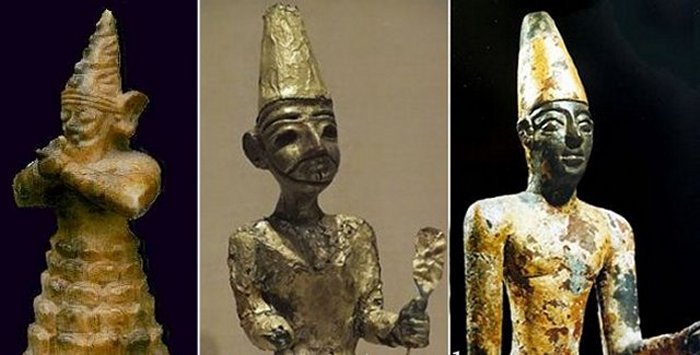
Left: Hittite figure of Baal: Canaanite God El - Megiddo, Modern Israel, c.1400 BC; Right: Phoenician deity Reshep, Byblos, 19th-18 century B
Other explanations suggest hats, quivers, calendars of a different kind, containers, crowns, and much more.
According to scientific studies, the 1,739 sun and half-moon symbols decorating the hat's surface make up a scientific, still undeciphered code which resembles 18.67-year cycle called the "Metonic Cycle" probably identified by Meton of Athens (born circa 460 B.C.; date of death unknown), a Greek mathematician, astronomer, geometer, and engineer.
But the problem is that the Meton's "discovery" took place 500 years after the mysterious conical hats were made.
Similar five golden cones were also unearthed in Ireland during the 17th and 18th centuries and even in many other places of prehistoric Europe, according to Prof Sabine Gerloff, a German archaeologist from Erlangen University, Germany and other researchers.
Written by – A. Sutherland AncientPages.com Staff Writer
Copyright © AncientPages.com All rights reserved. This material may not be published, broadcast, rewritten or redistributed in whole or part without the express written permission of AncientPages.com
Expand for referencesReferences:
D. Price, Europe Before Rome: A Site-by-Site Tour of the Stone, Bronze, and Iron Ages
More From Ancient Pages
-
 A Rare Pre-Roman Tomb Unearthed In Pompeii
News | Sep 22, 2015
A Rare Pre-Roman Tomb Unearthed In Pompeii
News | Sep 22, 2015 -
 Remarkable Underground City Of Nushabad: A Masterpiece Of Ancient Architecture
Ancient Technology | Nov 17, 2015
Remarkable Underground City Of Nushabad: A Masterpiece Of Ancient Architecture
Ancient Technology | Nov 17, 2015 -
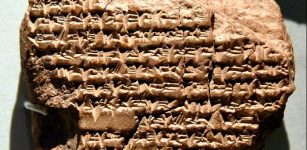 On This Day In History: Battle Of Gaugamela – Alexander The Great Defeats Darius III Of Persia – On Oct 1, 331 BC
News | Oct 1, 2016
On This Day In History: Battle Of Gaugamela – Alexander The Great Defeats Darius III Of Persia – On Oct 1, 331 BC
News | Oct 1, 2016 -
 Puzzling Jewellery From Grave Of High Status Viking Woman Delivered At Museum’s Door
Artifacts | Jul 23, 2022
Puzzling Jewellery From Grave Of High Status Viking Woman Delivered At Museum’s Door
Artifacts | Jul 23, 2022 -
 Largest Ancient Gold Treasure Of Its Kind Discovered In Stavanger, Norway
Archaeology | Sep 7, 2023
Largest Ancient Gold Treasure Of Its Kind Discovered In Stavanger, Norway
Archaeology | Sep 7, 2023 -
 On This Day In History: 55 Delegates Convened To Write What Would Become The U.S. Constitution – On May 14, 1787
News | May 14, 2016
On This Day In History: 55 Delegates Convened To Write What Would Become The U.S. Constitution – On May 14, 1787
News | May 14, 2016 -
 2,250-Year-Old Iron Age Settlement Discovered Near Upton-Upon-Severn
Archaeology | Jan 4, 2022
2,250-Year-Old Iron Age Settlement Discovered Near Upton-Upon-Severn
Archaeology | Jan 4, 2022 -
 ‘Sophisticated’ 4,000-Year-Old Steppe Pyramid Discovered In Kazakhstan
Archaeology | Aug 12, 2023
‘Sophisticated’ 4,000-Year-Old Steppe Pyramid Discovered In Kazakhstan
Archaeology | Aug 12, 2023 -
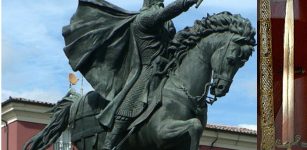 El Cid ’The Lord’ – Medieval Castilian Leader Known For His Courage And Extraordinary Military Skills
Featured Stories | Sep 20, 2021
El Cid ’The Lord’ – Medieval Castilian Leader Known For His Courage And Extraordinary Military Skills
Featured Stories | Sep 20, 2021 -
 Kadıkalesi Castle Ancient Ruins: Female Skeleton Unearthed At An Archaeological Dig
Archaeology | Jan 9, 2023
Kadıkalesi Castle Ancient Ruins: Female Skeleton Unearthed At An Archaeological Dig
Archaeology | Jan 9, 2023 -
 Babylonian Conquest Of Jerusalem As Told In The Bible – Evidence Found In Mount Zion
Archaeology | Aug 16, 2019
Babylonian Conquest Of Jerusalem As Told In The Bible – Evidence Found In Mount Zion
Archaeology | Aug 16, 2019 -
 Strangest Maps Ever Created – You Have Never Seen Our World Like This!
Artifacts | Jun 25, 2014
Strangest Maps Ever Created – You Have Never Seen Our World Like This!
Artifacts | Jun 25, 2014 -
 Aditi – Primeval Hindu Goddess Who Is Source Of All Living Beings
Featured Stories | Apr 3, 2021
Aditi – Primeval Hindu Goddess Who Is Source Of All Living Beings
Featured Stories | Apr 3, 2021 -
 Goddess Huitaca – Moon Goddess Of Intoxication, Joyful Life And Unlimited Pleasures In Muisca Mythology
Featured Stories | Mar 14, 2021
Goddess Huitaca – Moon Goddess Of Intoxication, Joyful Life And Unlimited Pleasures In Muisca Mythology
Featured Stories | Mar 14, 2021 -
 Mysterious Bronze Age Burial Chamber Discovered In Devon, UK
Archaeology | May 16, 2024
Mysterious Bronze Age Burial Chamber Discovered In Devon, UK
Archaeology | May 16, 2024 -
 Discovered 2000-Year-Old Mauryan Structure May Lead To The Lost Ashoka Pillar Site
Archaeology | Sep 30, 2021
Discovered 2000-Year-Old Mauryan Structure May Lead To The Lost Ashoka Pillar Site
Archaeology | Sep 30, 2021 -
 Jizo – Protector Of Children, Travelers And Women In Japanese Mythology
Featured Stories | Dec 23, 2015
Jizo – Protector Of Children, Travelers And Women In Japanese Mythology
Featured Stories | Dec 23, 2015 -
 DNA Sheds Light On The Iron Age Log Coffin Culture In Pang Mapha, Thailand
DNA | May 20, 2024
DNA Sheds Light On The Iron Age Log Coffin Culture In Pang Mapha, Thailand
DNA | May 20, 2024 -
 Was There An Explosion In The Great Pyramid In Antiquity?
Featured Stories | Aug 6, 2014
Was There An Explosion In The Great Pyramid In Antiquity?
Featured Stories | Aug 6, 2014 -
 Roman Square Capitals: Prestigious Script That Delighted Human Eye With Its Elegance
Featured Stories | Sep 16, 2019
Roman Square Capitals: Prestigious Script That Delighted Human Eye With Its Elegance
Featured Stories | Sep 16, 2019

